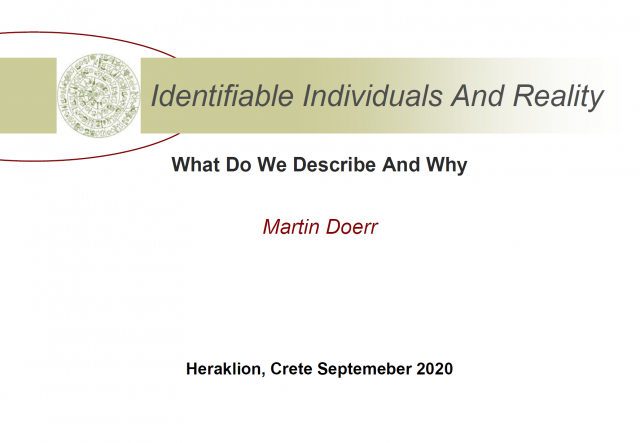ThinkSpatial: Martin Doerr

Identifiable Individuals and Reality
What Do We Describe and Why
Dr. Martin Doerr
Foundation for Research and Technology—Hellas (FORTH)
Abstract: Data of empirical-descriptive sciences, such as cultural heritage studies, geography, geology, biodiversity are usually kept in predicate-logic based information systems that refer to things in reality by unique identifiers. This can only work, if the referred features or phenomena, in reality, are distinct and can diachronically be identified in the same way by independent observers without a dialogue between them. In this presentation, we argue that only a smaller part of the features in our environment is sufficiently distinct over a useful time-span to form “identifiable individuals.” Different ontological categories can provide specific criteria about how parts of reality can be subdivided into “identifiable individuals” that turn out to be useful for modeling the behavior of reality as a result of observation, rather than convention, the so-called ontological individuation. We demonstrate (1) that there are always cases in which individuality is undecidable basically within all such categories, (2) that multiple individuals may overlap in substance in characteristic ways, and (3) that no such individual has precise spatiotemporal boundaries due to a variety of causes.
We argue that the kinds of conditions allowing for ontological individuation have widely not been studied, as well as what properties make phenomena not suited for individuation, such as clouds, stages of growth, flowing matter, and so forth. We further propose that the description of delimited situations in such systems, be it after observation or in prediction, needs to relate to identifiable individuals as reference. This epistemic individuation inherits the indeterminacy of the individuals of reference. We further propose that many kinds of scientific description of reality are an approximation that can be better processed via outer bounds. As a practical application, we show how adequate individuation criteria can substantially reduce the ambiguity of spatiotemporal gazetteers.
Bio: Dr. Martin Doerr is a Research Director at the Information Systems Laboratory and honorary head of the Centre for Cultural Informatics of the Institute of Computer Science, FORTH. He has been leading the development of systems for knowledge representation and terminology, metadata, and content management. He has been leading or participating in a series of national and international projects for cultural information systems. His long-standing interdisciplinary work and collaboration with the International Council of Museums on modeling cultural-historical information have resulted besides others in an ISO Standard, ISO21127:2006, a core ontology for the purpose of schema integration across institutions.
The objective of the ThinkSpatial Forum is to exchange ideas about spatial perspectives in research and teaching, broaden communication and cooperation across disciplines among faculty and graduate students, and encourage the sharing of tools and concepts.